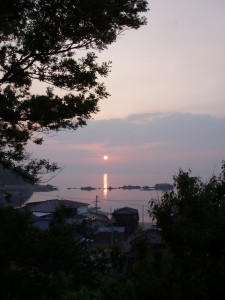The Association of Shrines put out a video in 2009 about human connectedhess with the environment. A woman dressed in white wanders through unspoilt nature with a voiceover that talks of the interconnectedness of life and the need for gratitude. it’s cute in the way Japanese appreciate. Nice, you might say. But is it genuine concern, or is it ‘greenwashing’?

The rising sun connects us all
Here’s the interesting thing: when you get to the end of the video, there’s nothing about asking people to get involved in protecting the environment, something sorely needed in Japan. There’s not even a hint of the terrible environmental degradation done to Japan by the Concrete State. No, there’s rather someone placing an ofuda in a single kamidana holder for Amaterasu. Why?
it’s all part of a massive Jinja Honcho campaign to promote Ise Jingu for its imperial primacy. It’s Amaterasu the ancestor of the emperor, not Amaterasu the sun that shines on everyone, that is the concern here. Breen and Teeuwen write: “The National Association of Shrines idealizes the prewar principle that shrines are ultiimately of imperial Japan, not of the local community… This is apparent in the imperial rites and prayers demanded of NAS priests, and the special position occupied by the Ise Shrines…” (A New History, p. 202)
In this way it could be said that Jinja Honcho is using an environmental pitch to promote its own imperial ends. Green Shinto by contrast believes in a grassroots environmentalism, where concerns at a local level are the focus. Amaterasu the sun goddess, not Amaterasu the imperial ancestor, would be the guiding spirit. A truly international and inclusive spirit.
Take a look at the video and see for yourself what you think…

The Sun Shining
For EveryOne
EveryWhere
Natural Environmentalism
Local Regional
Global Personal
Amaterasu Ecology
Each Morning Fresh
Its Own Way
-aj dickinson
It seems to me that the Japanese are truly thankful of nature, but don’t give much thought on protecting it. Maybe it is because they see nature more as something controlled by divine powers from above, and not something we mere human beings can control. They may consider the most important way to keep nature in harmony and balance to be making offerings to Kami.
I can imagine that the average Japanese person isn’t drowned in warnings of climate changes as much as elsewhere, and truly it must be rather nice to believe that nature is affected by mystical forces rather than seeing it as the result of human actions.
This way of thinking seems, of course, very naive, but I must admit that even though I believe that humans have caused a lot of damage on nature, and that we can change the way we use the resources of earth, it’s uncertain how much we can do about climate changes and natural disasters.
Great topic to bring up and relevant for the time.